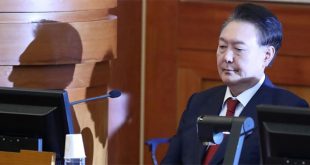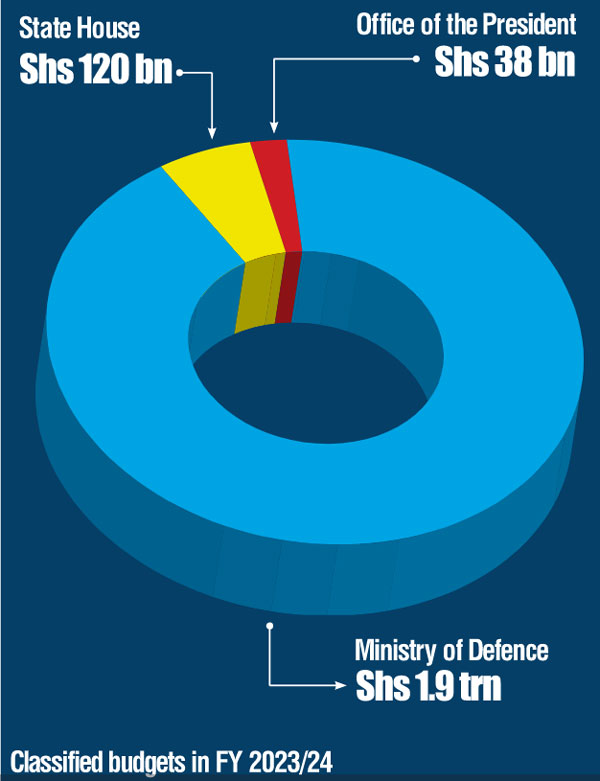
How State House, Office of the President, Ministry of Defense use the slush fund
Kampala, Uganda | IAN KATUSIIME | It is hard to ascertain for sure how much Uganda spends on its defence every year as the government routinely asks for supplementary budgets from parliament on top of the classified expenditure that is now a staple of Uganda’s budget.
Classified budgets have over time come become covers for the defence and security sectors to the chagrin of opposition politicians. In a minority report for annual budget estimates for FY 2023/24, Kira Municipality MP Ibrahim Ssemujju with four other MPs, queried the way the government plays around with classified expenditure while scrutinising Vote 004 of the Ministry of Defence and Veteran Affairs.
“The government has had a contractual commitment on classified expenditure that has cost Uganda a total of Shs16trillion over the contractual period,” the report notes. “The outlay for FY2022/2023 was Shs1.9trillion. This project has lapsed and will end in June 2023.”
Semujju and colleagues pinned the Ministry of Defence further, “Ironically, in this supplementary schedule for this year a sum of Shs339.8billion was moved from this contractual commitment and allocated to shortfalls in the wages for the UPDF.”
The report delves further into the details. “To our surprise under the budget estimates for FY 2023/24, a sum of Shs1.9trillion (the amount previously allocated to the contractual commitment has been allocated to retooling under classified expenditure without following the retooling guidelines of the PFM Act.”
In their minority report, the MPs were also irked by a decision by the Ministry of Finance to again deduct Shs339billion from the Shs1.9trillion to cater for wage shortfalls.
“Clearly there is a suspicious motive in the way theMinistry is trying to hold onto this money to the extent that they have now hidden it in the classified expenditure to avoid scrutiny,” the report noted.
The MPs who also included Muwanga Kivumbi (Butamabala County), Anne Adeke (Soroti District Woman), Goretti Namugga (Mawogola County) and Lulume Bayiga (Buikwe South) described the budgeting shenanigans as a form of “hemorrhaging public coffers” and called for the House to reject the Shs1.9trillion figure however classified.
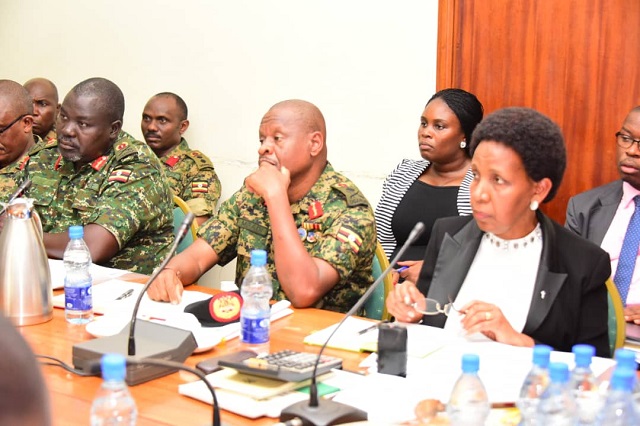
The Office of the President (Vote 001) has a total budget of Shs250billion of which Shs38billion is classified expenditure. State House has a total budget of Shs450billion with a classified expenditure of Shs120billion. The MPs recommended that tranches of classified expenditure in the President’s Office go into repairing roads since the House had already appropriated classified expenditure under Defence.
However as expected, the House did not adopt the report and the classified budgets stayed put as Minister of Finance Matia Kasaija read the budget for FY 2023/24 on June 15 at Kololo Ceremonial Grounds.
The government keeps classified budgets as a tightly guarded secret since the money ends up in operations run by Special Forces Command (SFC), Chieftaincy of Military Intelligence (CMI), and Internal Security Organisation (ISO) and on some occasions Police.
When The Independent sought out Defence Spokesperson Brig. Felix Kulayigye on what priorities the military would spend on this financial year, he reeled off the official line of soldiers’ welfare which includes housing, and other issues like capacity building but referred us to the ministerial policy statement.
The ministerial policy statement for the just ending FY 2022/23 listed some major achievement of the previous financial year as “The Ministry acquired and maintained defense classified equipment worth Shs994.7 billion to enhance UPDF strength and capacity in accordance with the technological advancement and changing security environment.”
The statement adds UPDF personnel who underwent training locally and abroad at a cost of Shs7 billion, food procurement at Shs100 billion, clothing items at Shs49 billion. It adds Petroleum Oil and Lubricants (POL) at Shs91 billion which were “acquired to ease mobility of equipment and materiel for troops in the Military Operations and maintenance of equipment.”
Routine Maintenance of Equipment is added for assets for both Air capabilities and Motor vehicles which were procured at cost of Shs12.4 billion. The total amount on the above items spent in FY 2021/22 comes to Shs1.2 trillion.
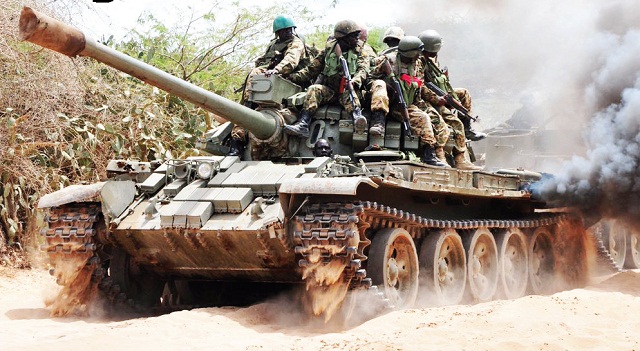
According to the medium term budget allocations, the Ministry of Defence budget for FY 2022/23 was Shs3.7 trillion, FY 2023/24 is Shs3.3 trillion and it averages out in that range until FY 2026/2027. The above figures do not account for the tranches of classified expenditure appropriated for Defence, Office of the President and State House.
During the budget reading last year, Kasaija revealed that Shs3.9 trillion (Approx. $US1 billion) had been allocated for “improvement of security and security infrastructure.” It wasn’t clear whether the money was meant for the UPDF alone as a base budget, or it covered UPDF’s foreign missions.
Uganda has learned some aspects of its defence budgeting from a key military ally: the United States. The superpower has the largest defence budget at US$849 billion for FY 2023 and it has grown exponentially over the last decade from US$600 billion. On top of the colossal sums of budget money spent on its military, the US Department of Defence also known as the Pentagon until recently had a separate pot of funding known as the Overseas Contingency Operations (OCO).
The OCO catered for U.S. military operations in Afghanistan and Iraq where the country had boots on the ground. As a separate budget item, OCO always drew criticism as a symbol of America’s war appetite and came to be known as a Pentagon slush fund. The Joe Biden administration ditched the OCO but security analysts and scholars always cited OCO as an enabler of America’s forever wars and an edifice of the U.S. military industrial complex.
In many ways, the OCO draws parallels with Uganda’s classified budgets, which are equally slush funds for Uganda’s security establishment. The Great Lakes region with some of its restive spots has seen Uganda grow into a regional security state with military interventions in DRC, South Sudan, Central Africa Republic, Equatorial Guinea, Liberia, and Somalia where it has had its most prominent role as a peacekeeping force. By some counts, Uganda has more than 15,000 troops on foreign soil with the largest troop presence in DRC and Somalia at 9,000 and 6,000 respectively.
The growth of troop numbers has had budgeting implications even as donors like the European Union pick up the tabs of the African Union Transition Mission in Somalia (ATMIS).
Evolution of defence budget
In the 37 years President Yoweri Museveni has been power, he has presided over an evolution of Uganda’s defence budget.
In 1986, when the National Resistance Army (NRA) captured power in Kampala its fighters did not have ranks. Formal ranks were introduced in 1988 as part of efforts to professionalise the army; with only President Museveni at Lt. Gen, and three Major Generals; Salim Saleh, Elly Tumwine, and Fred Rwigyema; and a handful of officers in the remaining upper ranks.
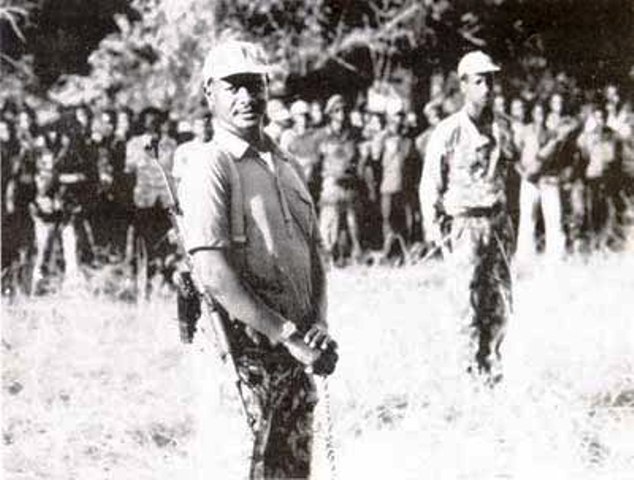
The NRA was a bare bones outfit mostly concerned with buying army uniforms, guns and other forms of ammunition. Its welfare planning was largely restricted to the barracks; food items and mobility of top commanders.
At the time, the NRA was facing a budding enemy in the Lords’ Resistance Army (LRA) led by former altar boy Joseph Kony who had launched his insurgency in 1987. By the time the NRA transitioned into the UPDF in 1994, it had attracted thousands of new entrants who were not part of the triumphant guerillas who had marched on Kampala in 1986.
The LRA rebellion went on for twenty years turning the UPDF into an experienced fighting force that saw a number of formidable army commanders at its helm such as Mugisha Muntu, James Kazini, Jeje Odong and Aronda Nyakairima.
Fast forward, the UPDF has an estimated 50,000 soldiers in six divisions including a Mountain Division that was created in 2019 to deal with the threat of the Allied Democratic Forces (ADF) operating in the jungles of eastern DRC.
Since 2000, Uganda has acquired combat helicopters, tanks, towed guns, Armoured Personnel Carriers (APCs), infantry fighting vehicles (IFVs), and its most prized asset to date; the Sukhoi SU-30MK jets. While purchasing these high value acquisitions, Uganda has traded with heavy hitters in the arms industry like U.S., Russia, China, and France. The four are the largest military spenders according to SIPRI, a tracker of the global arms industry.
Uganda has also done business with military contractors. In 2021, SFC hired a Chinese military contractor Poly Technologies for delivery of APCs. Uganda has also worked with another Chinese military contractor, Norinco for IFVs. It is hard to get contract figures since all these were most likely classified dealings.
Sukhoi jets
Uganda’s military ambitions led to unprecedented levels of fiscal indiscipline as it emerged that in 2011, the government had raided Bank of Uganda reserves without parliament’s approval to pay for six Sukhoi SU-30MK fighter jets from Russia at a price of $635m according to SIPRI.
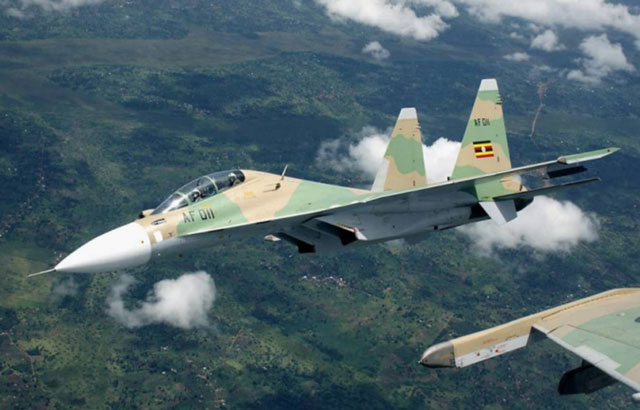
The decision to acquire the fighter aircraft stirred indignation and led to a severe economic crisis and a drastic tumbling of the Uganda shilling.
Some estimates say the purchase shot Uganda’s expenditure up by 300% sparking an arms race in the Great Lakes region. It also elevated Uganda’s Air Force as arguably the most advanced in the region.
At the time, Uganda was at loggerheads with Sudan having backed the cessation of South Sudan from its northern neighbour and the government defended the purchase of the aircraft as preparation for any “eventuality.”
It was a major move because in the preceding three years, Uganda spent on six light helicopters from Austria, 3 L-39Z Albatros jet trainers (combat aircraft) from Bulgaria and five APC tanks from China, data from SIPRI show.
The amount Uganda paid for the above items was not indicated but the data indicate it must have been a drop in the ocean compared to what Uganda splurged on the combat aircraft going and given the resulting economic implications.
Last year after a period of ten years in stock, Uganda contracted Indian state-owned aerospace and defence company, Hindustan Aeronautics Limited (HAL) for the maintenance of the jets. Indian company HAL has a manufacturing license from Russia to build the jets and other variants of the Sukhoi MK30.
An MoU for the maintenance was signed on March 4, 2022 at the Indian High Commission in Kampala. Lt. Gen. Charles Lutaaya, Commander of Air Force in the UPDF, signed on behalf of Uganda. The Indian High Commission on its Twitter account said the deal was the first major defence agreement with Uganda.
UPDF used the SU-30MK fighter jets in the revenge bombing of camps belonging to the ADF in November 2021 at the start of the hunt for ADF militants in DR Congo in Operation Shujaa after the group staged a bomb attack in Kampala that same month.
 The Independent Uganda: You get the Truth we Pay the Price
The Independent Uganda: You get the Truth we Pay the Price

